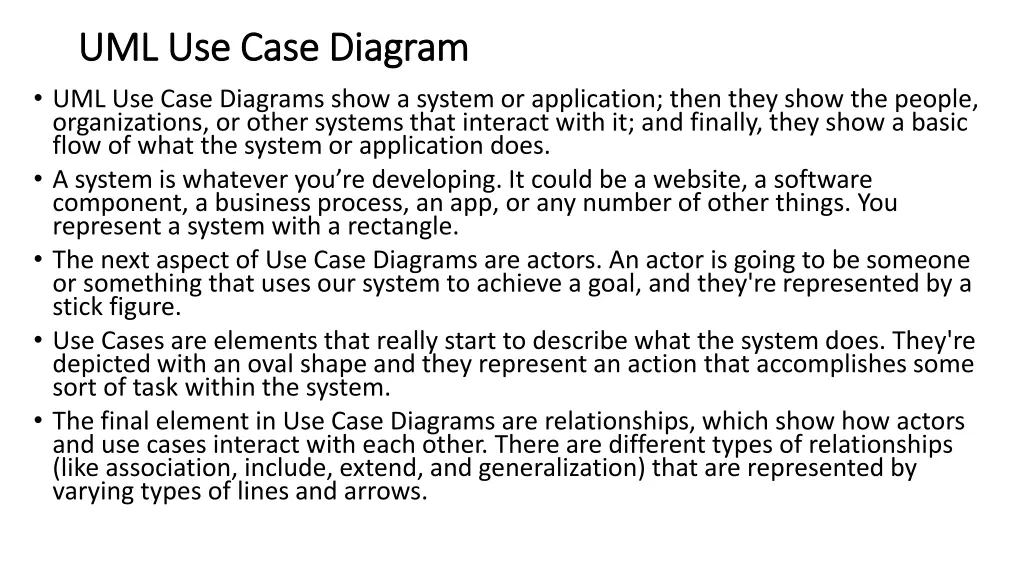
Understanding Use Case and Class Diagrams in Software Development
Learn about Use Case Diagrams, which depict how a system interacts with its users and show the basic flow of the system's actions. Explore Class Diagrams describing the static structure of a system by illustrating classes and their relationships like generalization, association, and aggregation. Understand the significance of attributes, operations, and associations in modeling software systems.
Download Presentation

Please find below an Image/Link to download the presentation.
The content on the website is provided AS IS for your information and personal use only. It may not be sold, licensed, or shared on other websites without obtaining consent from the author. If you encounter any issues during the download, it is possible that the publisher has removed the file from their server.
You are allowed to download the files provided on this website for personal or commercial use, subject to the condition that they are used lawfully. All files are the property of their respective owners.
The content on the website is provided AS IS for your information and personal use only. It may not be sold, licensed, or shared on other websites without obtaining consent from the author.
E N D
Presentation Transcript
UML Use Case Diagram UML Use Case Diagram UML Use Case Diagrams show a system or application; then they show the people, organizations, or other systems that interact with it; and finally, they show a basic flow of what the system or application does. A system is whatever you re developing. It could be a website, a software component, a business process, an app, or any number of other things. You represent a system with a rectangle. The next aspect of Use Case Diagrams are actors. An actor is going to be someone or something that uses our system to achieve a goal, and they're represented by a stick figure. Use Cases are elements that really start to describe what the system does. They're depicted with an oval shape and they represent an action that accomplishes some sort of task within the system. The final element in Use Case Diagrams are relationships, which show how actors and use cases interact with each other. There are different types of relationships (like association, include, extend, and generalization) that are represented by varying types of lines and arrows.
C Class Diagrams lass Diagrams A class diagram describes the static structure of a system. It shows how a system is structured rather than how it behaves. The static structure of a system comprises of a number of class diagrams and their dependencies. The main constituents of a class diagram are classes and their relationships: generalization, aggregation, association, and various kinds of dependencies. Classes The classes represent entities with common features, i.e. attributes and operations. Classes are represented as solid outline rectangles with compartments. The class names are usually chosen to be singular nouns.
C Class Diagrams lass Diagrams Attributes An attribute is a named property of a class. It represents the kind of data that an object might contain. Attributes are listed with their names, and may optionally contain specification of their type, an initial value, and constraints. E.g. bookName : String Operation Operation is the implementation of a service that can be requested from any object of the class to affect behaviour. An object s data or state can be changed by invoking an operation of the object. A class may have any number of operations or no operation at all. The parameters of an operation (if any), may have a kind specified, which may be in , out or inout . E.g. issueBook(in bookName):Boolean
C Class diagrams lass diagrams Association Associations are needed to enable objects to communicate with each other. An association describes a connection between classes. The association relation between two objects is called object connection or link. Links are instances of associations. A link is a physical or conceptual connection between object instances. For example, suppose Amit has borrowed the book Graph Theory. Here, borrowed is the connection between the objects Amit and Graph Theory book. An association describes a group of links with a common structure and common semantics. For example, consider the statement that Library Member borrows Books. Here, borrows is the association between the class LibraryMember and the class Book.
Class diagrams Class diagrams Composition Composition is a stricter form of aggregation, in which the parts are existence-dependent on the whole. This means that the life of the parts closely ties to the life of the whole. When the whole is created, the parts are created and when the whole is destroyed, the parts are destroyed. A typical example of composition is an invoice object with invoice items. As soon as the invoice object is created, all the invoice items in it are created and as soon as the invoice object is destroyed, all invoice items in it are also destroyed. The composition relationship is represented as a filled diamond drawn at the composite- end.
UML class diagram for Online Shopping cart UML class diagram for Online Shopping cart
